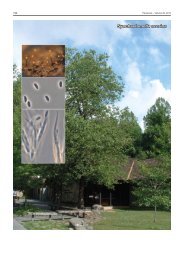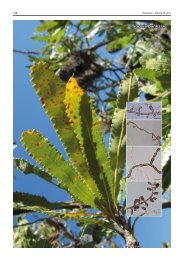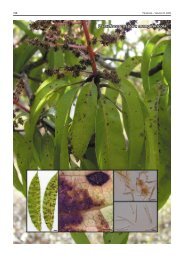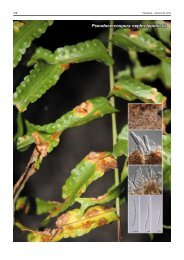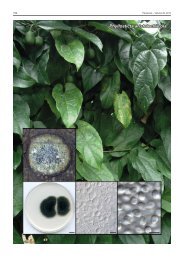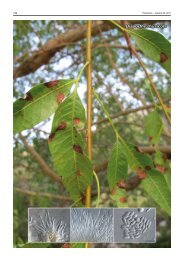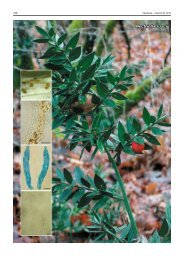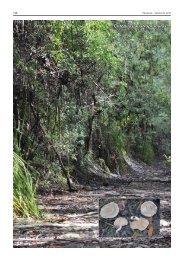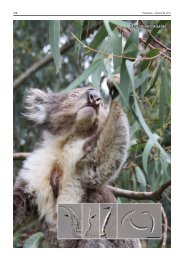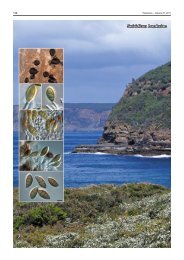Toxicocladosporium banksiae - Fungal Planet
Toxicocladosporium banksiae - Fungal Planet
Toxicocladosporium banksiae - Fungal Planet
You also want an ePaper? Increase the reach of your titles
YUMPU automatically turns print PDFs into web optimized ePapers that Google loves.
146 Persoonia – Volume 25, 2010<br />
<strong>Toxicocladosporium</strong> <strong>banksiae</strong>
Persoonial Reflections<br />
147<br />
<strong>Fungal</strong> <strong>Planet</strong> 63 – 23 December 2010<br />
<strong>Toxicocladosporium</strong> <strong>banksiae</strong> Crous, R.G. Shivas & McTaggart, sp. nov.<br />
Toxicocladosporio veloxo simile, sedconidiis terminalibus majoribus, (7–)8–<br />
10(–11) × (2–)2.5–3 µm, distinguitur.<br />
Etymology. Named after the host from which it was collected, Banksia.<br />
Mycelium on potato-dextrose agar consisting of smooth,<br />
septate, branched hyphae, dark brown, 2.5–4 µm diam; walls<br />
and septa becoming dark brown and thickened with age.<br />
Conidiophores solitary, dimorphic, macronematous, or micronematous,<br />
reduced to conidiogenous cells. Macronematous<br />
conidiophores subcylindrical, straight to geniculate-sinuous,<br />
unbranched or branched above, 3–7-septate, dark brown,<br />
smooth, walls and septa thick, dark brown, 50–130 × 3–4 µm.<br />
Micronematous conidiophores reduced to conidiogenous cells<br />
(rarely with one or two supporting cells), erect, subcylindrical to<br />
doliiform, tapering at apex, 10–40 × 2.5–4 µm. Conidiogenous<br />
cells integrated, terminal or lateral, subcylindrical, with slight<br />
taper towards apex, 6–20 × 2.5–3 µm; proliferating sympodially<br />
with 1–3 apical, protruding loci, 1–1.5 µm wide, thickened,<br />
darkened and refractive. Conidia catenate in branched or<br />
unbranched chains, medium to dark brown, thick-walled, with<br />
dark, thick septa, finely verruculose; ramoconidia (14–)17–25<br />
× (2.5–)3–4 µm, 0–1-septate, constricted at septa, broadly<br />
ellipsoid to subcylindrical; intercalary conidia ellipsoid to ovoid,<br />
10–12(–20) × (2.5–)3–3.5 µm, 0–1-septate, apical conidia<br />
pale to medium brown, aseptate, (7–)8–10(–11) × (2–)2.5–3<br />
µm; hila protruding, 1–1.5 µm wide, thickened, darkened and<br />
refractive.<br />
Culture characteristics — (in the dark, 25 °C, after 2 wk):<br />
Colonies erumpent, spreading, folded, with sparse aerial mycelium<br />
and even, lobate margins, reaching up to 7 mm diam.<br />
On malt extract agar surface pale olivaceous-grey, reverse<br />
olivaceous-grey; on oatmeal agar olivaceous-grey; on potatodextrose<br />
agar olivaceous-grey (surface and reverse).<br />
Typus. Australia, Queensland, Noosa National Park, 26°34'14.0"S<br />
153°4'21.6"E, on leaves of Banksia emulata, 13 July 2009, P.W. Crous,<br />
R.G. Shivas & A.R. McTaggart, CBS-H 20496 holotype, cultures ex-type<br />
CPC 17281, 17280 = CBS 128215, ITS sequence of CPC 17280 GenBank<br />
HQ599598 and LSU sequence of CPC 17280 GenBank HQ599599, Myco-<br />
Bank MB517544.<br />
Notes — A search of GenBank using the LSU sequence<br />
retrieved as closest sisters <strong>Toxicocladosporium</strong> chlamydosporum<br />
(GenBank FJ790302; Identities = 854/864 (99 %),<br />
Gaps = 4/864 (0 %)), <strong>Toxicocladosporium</strong> irritans (GenBank<br />
EU040243; Identities = 853/864 (99 %), Gaps = 4/864 (0 %))<br />
and <strong>Toxicocladosporium</strong> veloxum (GenBank FJ790306; Identities<br />
= 853/864 (99 %), Gaps = 4/864 (0 %)). Two of these three<br />
species were also obtained when a megablast was performed<br />
with the ITS sequence, albeit with a slightly lower sequence<br />
identity (T. veloxum GenBank FJ790288, Identities = 596/615<br />
(97 %), Gaps = 11/615 (1 %) and T. chlamydosporum GenBank<br />
FJ790284, Identities = 596/617 (97 %), Gaps = 13/617 (2 %)).<br />
Based on the DNA sequence data of the ITS gene, T. <strong>banksiae</strong><br />
is closely related to T. veloxum and T. chlamydosporum 1 .<br />
<strong>Toxicocladosporium</strong> veloxum has smaller intercalary (9–12 ×<br />
2.5–3 μm) and terminal (8–10 × 2–2.5 μm) conidia. In T. chalamydosporum<br />
the ramoconidia (15–18 × 2.5–4 μm), intercalary<br />
(8–11 × 3–3.5 μm) and terminal conidia (6–9 × 2.5–3<br />
μm) are smaller, and T. <strong>banksiae</strong> lacks chlamydospores. There<br />
is also a significant difference in the ITS sequence between<br />
T. <strong>banksiae</strong> and T. protearum (described as <strong>Fungal</strong> <strong>Planet</strong> 57<br />
elsewhere in this volume), Identities = 636/655 (98 %), Gaps<br />
= 10/655 (1 %).<br />
Colour illustrations. Noosa National Park; colony on malt extract agar;<br />
conidiophores with conidiogenous cells giving rise to conidia. Scale bar =<br />
10 µm.<br />
Reference. 1 Crous PW, Wingfield MJ, Groenewald JZ. 2009. Niche sharing<br />
reflects a poorly understood biodiversity phenomenon. Persoonia 22:<br />
83–94.<br />
Pedro W. Crous & Johannes Z. Groenewald, CBS-KNAW <strong>Fungal</strong> Biodiversity Centre, P.O. Box 85167, 3508 AD Utrecht, The Netherlands;<br />
e-mail: p.crous@cbs.knaw.nl & e.groenewald@cbs.knaw.nl<br />
Roger G. Shivas & Alistair R. McTaggart, Agri-Science Queensland, Ecosciences Precinct, Dutton Park 4102, Queensland, Australia;<br />
e-mail: roger.shivas@deedi.qld.gov.au; alistair.mctaggart@deedi.qld.gov.au<br />
© 2010 Nationaal Herbarium Nederland & Centraalbureau voor Schimmelcultures



